Top News
November 15, 2011 Ryukyu Shimpo
In order to support and enhance Okinawan companies’ activity in Asia, Bank of the Ryukyus (President Isao Oshiro) has concluded an advisory contract with Asison Inc. (Tokyo, President Shigehiro Aihara), an external consultancy specializing in employment introductions in Asian countries. Seeking to benefit from Aihara’s experience, the Bank of the Ryukyus hopes to help prepare the way for companies to expand their businesses overseas, including into Shanghai and Hong Kong in China, and Thailand and Singapore.
President of the Bank of the Ryukyus Isao Oshiro states that support for local companies’ business efforts in Asia is one of its most important strategies, and they will commence this from December. The bank has already established ties with the DBJ Asia Financial Support Center of the Development Bank of Japan and the Kasikorn Bank PCL, the major bank in Thailand. The bank also has dispatched staff to the Japan External Trade Organization (JETRO) in order to create a network.
Collaborating with Asison, Bank of the Ryukyus will deal with clients’ approaches based upon advice they receive from President Aihara. Furthermore, they intend to further lift effectiveness by providing information on Asian politics and economics, holding study meetings for employees, and by setting up Asian business meetings.
During his many years living in Hong Kong, Aihara worked as the president of Japanese-language school, was a board member of the Japanese recruitment firm Pasona Asia Co., Ltd, as a president of the Japanese language newspaper the Hong Kong Post and is currently a trade advisor for the Hong Kong Trade Development Council. He is familiar with Okinawa through his experience holding seminars there on Asian business.
The spokesman explained, “There are many people who don’t know where to go for help and what to start with to make inroads into the Asian market, so we think there is a potential demand for this service. We are building a framework for those who have questions so they can visit our bank for assistance.”
As a new strategy for growth, the Japanese government intends to expand the business activities in Asia of small and medium-sized Japanese businesses, and in that context, it is pushing ahead with assistance for financial institutions.
(English Translation by T&CT, Shinako Oyakawa and Mark Ealey)
Go To Japanese
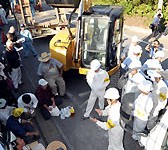
November 16, 2011 Ryukyu Shimpo
On the morning of November 15, the Okinawa Defense Bureau recommenced the construction of the new helipads at Takae in Higashi Village in keeping with the partial return of the U.S. Northern Training Area. Takae residents and civic groups staged sit-in protest in front of the gate. Although heavy equipment was not brought in, survey work of the area was carried out.
With regard to the vehicles that civic groups and a political party have parked in front of the gate since the end of June in order to prevent the construction, Nago Police Station issued a warning to the people, saying, “Parking in front of a gateway is a violation of the Road Traffic Law.” This is the first warning by the police.
According to the residents, Okinawa Defense Bureau staff members and construction workers arrived at the area around 10:18am. They moved a loading shovel towards the gate, but could not get it into the area because of the protest. Workers only went as far as conducting a survey of the area. Just a few people were in front of the gate to begin with, but about 40 to 50 people rushed to the scene following the arrival of the Defense Bureau staff.
In front of the gate, Defense Bureau staff repeated, “Please let us start the construction,” while residents responded, “Let’s discuss this,” and “Please do not start the construction.” The stand-off continued as staff members of the Defense Bureau videotaped the residents’ protest.
Masatsugu Isa from the Residents Association Against the Helipad Construction said, “I don’t understand why they look to restart the construction at this time. I think that they are trying to show the Japanese government that they are doing something on the construction.” Construction workers had previously not visited the site in the nine months since February.
(English Translation by T&CT, Megumi Chibana and Mark Ealey)
Go To Japanese
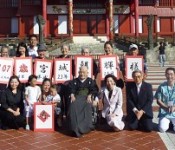
November 16, 2011 Ryukyu Shimpo
On November 15, a photo session to celebrate the birthday of Choki Miyagi, who turned 107 year-old and is the oldest man in Naha, was held at the Una Forecourt of Shuri Castle. Approximately 40 people, including staff of the Multifunctional Long-Term Center in a Small Group Home Umanchu Shuri, where Miyagi has stayed, his friends and family came to the celebration and congratulated him on his longevity.
Miyagi was born and raised in Shuri, but this was the first time in his life to visit the refurbished Shuri Castle. “It has changed from how it used to be,” he said, gazing at the castle with deep emotions at play in his mind. His 79 year-old eldest daughter Yoshiko Mekaru smiled, saying, “He seems to be glad that so many people have come to celebrate his birthday.”
“Everyone is congratulating me, so I am happy. Where should I celebrate next year? Let me know if you know of a good place, ” said Miyagi with a smile.
(English Translation by T&CT, Lima Tokumori and Mark Ealey)
Go To Japanese

November 13, 2011 Ryukyu Shimpo
On November 12, the opening ceremony of the “Maison de Okinawa” (Okinawan House), a facility with an assembly room and exhibition hall for the New Caledonia Okinawa Kenjinkai (Nouvelle Caledonie Descendants D’Okinawa), was held at Poindimie City in New Caledonia.
About 300 people, including Marie-Jose Michel, the Honorary Consul of Japan, and Paul Neaoutyne, the Poindimie City Mayor and Governor of the Northern Region attended the ceremony. They celebrated the completion of the complex, which will be used by people of Okinawan descent both as a place for relaxation and as a center for creating a closer relationship between New Caledonia and Okinawa.
A former president of the Okinawan Japanese Community Association of New Caledonia, 58 year-old Jean-Pierre Zenkuro, who is san-sei (third-generation Okinawan) and whose grandfather was from Nago, suggested that they establish the Okinawan House and provided the land to build it on. He has pushed ahead with the preparation of the facility, which is intended to deepen friendship and boost exchanges with Okinawan people.
Yvan Obry who is the president of the New Caledonia Okinawa Kenjinkai gave a speech at the opening ceremony, saying, “I hope that everyone will look after the facility and make good use of it for the sake of friendship.” Takeshi Miki, the president of Okinawa-New Caledonia Friendship Association stated, “The meaning of ‘Okinawa’ of ‘Okinawan House’ also means ‘Ookina-wa’ (‘large circle’) in Japanese. Let’s try to expand our circle of friendship.” He also went on to read out messages from Okinawa Governor Hirokazu Nakaima and Nago Mayor Susumu Inamine.
At the opening ceremony, Mayor Neaoutyne, President Obry and President Miki cut the tape, and the local residents provided entertainment including a Tahitian dance. A photo exhibition of the 5th Worldwide Uchinanchu Festival attracted the attention of the participants.
Zenkuro who attended the opening ceremony said, “I am very pleased that the Okinawan House has been constructed on the land that we put aside for it.”
(English Translation by T&CT, Lima Tokumori and Mark Ealey)
Go To Japanese
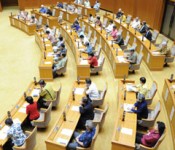
November 15, 2011
In an extraordinary meeting held on November 14, the Okinawa Prefectural Assembly, chaired by Zenshin Takamine, unanimously decided to ask the central government not to submit the evaluation report on the environmental impact of the relocation of United States Marine Corps Air Station Futenma to Henoko in Nago. The written statement will be sent to the Prime Minister, Defense Minister, Foreign Minister and Minister in Charge of Okinawa. Through this statement, the Assembly has once again indicated its strong desire to reject the government’s plan to move forward with the legal procedures related to relocating the facilities at Futenma within the prefecture.
A delegation from the Okinawa Prefectural Assembly mainly comprising people on the Special Committee on U.S. Military Bases (chairperson – Kiyoko Tokashiki) will visit the Okinawa Defense Bureau and Okinawa Liaison Office of the Ministry of Foreign Affairs on November 17 to hand over the statement. On November 18, the delegation members will also visit Tokyo to make the same request directly to the Prime Minister and Defense Minister.
In the written statement, the Assembly criticized the central government’s intention to submit the evaluation report before the end of this year, pointing out that, “This is an attempt to avoid the situation in which the success or failure of the Defense Authorization Bill in the U.S. Senate, which is under pressure to cut defense spending, pushes both governments into a corner on the relocation plan,” and that such an attitude, “runs counter to the will of the people of Okinawa Prefecture, and as such is not something that can be overlooked.” The Assembly requested that the government abandon the submission of the evaluation report, and again expressed its opposition to the plan to relocate Futenma within Okinawa, instead requesting relocation outside of the prefecture.
Yoshihiko Yoshimoto, a member of the Assembly from Nago and the Liberal Democratic Party, had indicated that he would abstain from voting, but he was absent due to ill health.
Assembly Chairman Takamine was critical of the news that during his meeting with U.S. President Barack Obama at the U.S.-Japan summit held in Honolulu on November 12 Prime Minister Yoshihiko Noda vowed to submit the evaluation report before the end of the year. He said, “There has not been sufficient explanation, and there is no level of understanding or cooperation from the people. It is a statement that seems like a snap decision.” At his press conference after the extraordinary meeting he said, “That our written statement was unanimously supported is very significant. We would like the government to respect the Assembly resolution in accordance with the Local Government Act.”
(English Translation by T&CT, Mark Ealey)
Go To Japanese

Go To Video1
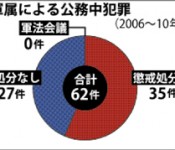
November 13, 2011 Hideki Matsudo of Ryukyu Shimpo
Of the 62 cases of crime or incidents involving U.S. military civilian employees in Japan that have occurred “in the line of duty” during the five-year period of 2006-2010, it was recently divulged that none of those have been brought to a court-martial, and 27 cases, or approximately 40% of those, were processed as being “not subject to punishment.” In 35 cases, disciplinary action against the suspected civilian employees was taken. Based on the U.S.-Japan Status of Forces Agreement, if a U.S. military civilian employee causes a traffic accident while on duty, the Japanese side is required to turn the jurisdiction of the case over the United States authorities. However, it was revealed that after Japanese side renounced the right of jurisdiction, the U.S. military has wound up the cases without bringing the civilian suspects to a court-martial, or even without imposing any criminal penalties on them.
On November 11, the Justice Ministry responded to a question from Member of the House of Councilors Satoshi Inoue (Japanese Communist Party) and produced the relevant material. According to the explanation given by Inoue, the cases of crime and incidents involving U.S. civilians have mostly been traffic accidents. The U.S.-Japan Status of Forces Agreement states that in the case of the traffic accidents caused by U.S. military service members and civilians “on duty,” the primary jurisdictions over this is determined to be with the United States. Meanwhile, the results of the exercise of jurisdiction or disposal of cases by the U.S. military side after the Japanese side has given up jurisdiction have not so far been revealed.
According to a summary released by the Justice Ministry, the number of crimes committed by U.S. civilian personnel on duty during 2006 was four, with two cases resulting in disciplinary action and two not subject to punishment. During 2007, it was 16 cases, including nine that resulted in disciplinary action and seven cases not subject to punishment. During 2008, it was 19 cases, including 12 resulting in disciplinary action and seven not subject to punishment. In 2009 it was 12 cases, eight involving disciplinary action and four not subject to punishment. During 2010, it was 11 cases, including four resulting in disciplinary action and seven not subject to punishment.
(English translation by T&CT, Mark Ealey)
Go To Japanese

November 13, 2011 Ryukyu Shimpo.
On November 12, Defense Minister Yasuo Ichikawa, who is now visiting Okinawa Prefecture, held a press conference at the Okinawa Defense Bureau regarding the submission of a written evaluation on the environmental impact of the reclamation of the coastal area of Henoko, Nago City for construction of replacement facilities for the United States Marine Corps Air Station (USMCAS) Futenma. Ichikawa expressed his view that it will be possible to submit the environmental impact report to the prefecture before the end of the year, saying, “I have received word that it is possible for the staff of the Okinawa Defense Bureau to submit it before the end of the year. I am confident about that.”
Ichikawa did not clearly state the deadline for the submission, saying, “This is not an issue that can be resolved by setting a deadline.”
However, once again he stressed that the report would be submitted before the end of the year.
Regarding the progress on submission of the report, Ichikawa confirmed the following: first, Japanese Defense Ministry’s formal reaction to Okinawa Governor Hirokazu Nakaima’s opinion of the preparation documents of the environmental impact report, and second, the progress of environmental impact assessment based on the location and configuration of the replacement facility for Futenma Air Station that was decided at the Japan-U.S. Security Consultative Committee (2+2) held in June 2011. Ichikawa also received a report regarding the operations based on the deployment of Osprey aircraft to the replacement facility.
Ichikawa unofficially met with Nakaima at a hotel in Naha in the morning of November 12. The Minister of Defence told Nakaima that the Japanese government is in the process of preparing to submit the evaluation report [on the environmental impact of the relocation] before the end of this year. He also stressed to the Governor of Okinawa that the government is putting emphasis on reducing the military burden on the prefecture.
In response, Nakaima again demanded the relocation of Futenma Air Station outside of the prefecture and made his stance clear on the possibility of not relocating Futenma Air Station in the case that the Henoko plan does not work, by saying, “Keeping the facilities at Futenma is fundamentally wrong.”
After his meeting with Nakaima, Ichikawa indicated that the Japanese government would request the Okinawan people’s understanding in regard to the submission of the report, saying, “We will not force the report on the prefecture. We would like to carefully explain it to the people of Okinawa and move ahead with the process. There are legal procedures available in this respect, but we do not consider that this should be approached in a unilateral manner.”
(English Translation by T&CT, Mark Ealey)
Go To Japanese
November 12 2011, Ryukyu Shimpo
On November 11, Japanese Prime Minister Yoshihiko Noda officially announced that Japan will participate in talks on the Trans-Pacific Partnership trade agreement (TPP).
Many people in the Okinawan business community expressed concern about Japan’s participation in the TPP talks, saying, “Participation in these talks will have a serious impact on the Okinawan economy. It will destroy Okinawan agriculture.” However, but at the same time, some had positive things to say, such as, “It is important for Japan to be at the negotiating table” and “I expect that Noda will negotiate properly with the countries participating in the TPP.”
Anyu Onaha, head of Japan Agricultural Cooperatives Okinawa, criticized Noda’s announcement, saying, “Japan’s participation in the TPP is an issue that divides opinions within the ruling party, the Democratic Party and the entire nation. With this the case, Japan is undemocratic if the government goes ahead and participates in the negotiations.” He then went even further to say, “We have been looking after Okinawan agriculture within the context of agricultural liberalization. TPP could destroy Japanese agriculture. It is very clear that TPP could also put paid to Okinawan agriculture. I strongly oppose Japan’s participation in TPP.”
Yoshimi Teruya, head of the Okinawa Constructors Association pointed out that the United States government has been requesting that the Japanese government abolish the regional requirement that exclusively limits the location of the tenderer. Teruya said, “Japan’s participation in TPP could lead to the abolishment of this regional requirement, which could be a mortal blow to the regional construction industry, and as a result, the local economy could be seriously affected.” Teruya is opposed to Japan’s participation in TPP, saying, “I will be paying close attention to how the negotiations unfold.”
Shigenobu Asato, head of the Okinawa Convention and Visitors Bureau said, “I am very disappointed that this decision was made so easily, almost as though we needed to avoid missing the boat.” Regarding the impact of Japan’s participation in TPP on Okinawa, Asato said, “An incoming flow of human resources is expected in the field of Okinawan tourism. Okinawa already has a high unemployment rate and the number of foreign migrant workers is expected to increase. This will have a great impact on Okinawa.”
Morihide Ogido, head of the Okinawa Prefectural Federation of Societies of Commerce and Industry expressed a sense of caution with regard to Japan’s participation in TPP, saying, “While the pros and cons are being batted back and forth by all parties, we are concerned that the elimination of tariffs could be very detrimental to the local economy in Okinawa. I ask that the government proceed very carefully in the negotiations.”
Yukikazu Kokuba, head of the Council of Okinawa Prefectural Economic Organizations (head of the Okinawa Prefectural Federation of Chamber of Commerce and Industry), said, “It is good for Japan to be at the negotiating table. Japan may very well be participating in the TPP talks, but the United States itself has many import restrictions. There are no inherent concerns here with regard to taking part in the talks. It is important for the Japanese government to negotiate properly with the countries participating in the TPP. There it nothing strange about taking part in these talks.”
Shinkou Kuniyoshi, head of the Okinawa Federation of Fisheries Cooperative, expressed his opinion saying, “There is a concern that Japan’s participation in TPP could be detrimental to primary industries, but you cannot tell what will happen unless you actually participate in the talks. I think that it is good that Noda has made efforts to step forward on this. I expect the government to carry out proper negotiations with the countries participating in TPP.”
(English Translation by T&CT, Mark Ealey)
Go To Japanese
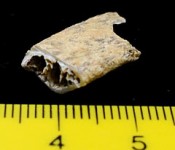
November 11, 2011 Ryukyu Shimpo
Twenty four thousand year-old human remains have been freshly discovered at the Shiraho Saonetabaru Cave Ruins in Ishigaki City. Previously, the oldest find from these ruins were 20000 year-old human bones dating back to the Paleolithic era. Physical anthropologist, Associate Professor Minoru Yoneda and his laboratory team from the University of Tokyo extracted the protein component “collagen” from a part of rib bones discovered in last year’s excavation, and conducted carbon measurement.
Bones from animals such as boar and birds were also found from the same ruins. Yoneda says, “Human habitation of the Ryukyu Archipelago during the Paleolithic era is now confirmed. This may assist in explaining life in those times and human evolution in East Asia.”

Associate Professor Minoru Yoneda
The ruins are located within the planned construction site of the New Ishigaki Airport. Human bones excavated there three years ago during a dig carried out by the prefecture were verified to date back 20000 years. This April, Associate Professor Yoneda reported that another piece of human bone had been discovered from stratum between 20000 and 24000 years old.
During the three months since August, an urgent full-scale excavation was conducted in which approximately 300 pieces of human bone were discovered from the stratum. New discoveries to explore the roots of Japanese and Okinawa’s connections to the Jomon period are expected.
Although the construction for the New Ishigaki Airport is proceeding for its opening in March 2013, Yoneda says, “There are no other ruins in the country. Additional excavations should be carried out before the airport project is completed.”
In Okinawa, other human bone fossils such as the Yamashita Cave man (32000 years ago), Minatogawa Man (18000 years ago) have been found. The fossils’ ages are estimated based on measurement of materials such as carbon excavated together with the fossil.
(English Translation by T&CT, Megumi Chibana and Mark Ealey)
Go To Japanese
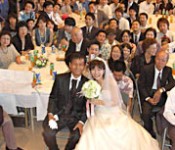
November 11, 2011 Yukiyo Zaha of the Ryukyu Shimpo
On November 5, Shinnosuke Imazu, the leader of the NPO xBridge, a group involved in the administration of the Nanjo Citizens’ College, and his bride Yumiko, held their civil wedding at the Chinen Social Welfare Center in Nanjo City as part of an economic development project for the area. Members of the Citizens’ College carried out the preparations for the reception with dishes featuring local products such as vegetables, mozuku (seaweed appetizer) and irabu (sea snake) soup from Kudaka Island, being provided to the 300 guests, allowing it to also serve as a wedding-event to help promote the region.
Imazu has been to Kudaka Island regularly for the last seven years, and was stimulated “to think about what is important in life.” He started to become involved in the Citizens’ College and this heightened his feelings about boosting local development.

At the Chinen Social Welfare Center in Nanjo City on November 5, the food provided at the wedding was mostly local produce.
After registering their marriage in June, he thought that he would like to celebrate with people important to him in Nanjo, a place with which he has a deep relationship and special feelings towards.
The couple originally planned to hold a garden wedding in Chinen Cape Park, which is located near
Seifa-Utaki and offers views of the blue ocean and Kudaka Island, and had been preparing for two months for that, but bad weather on the day of the wedding meant that the reception had to be held indoors.
Nanjo City Mayor Keishun Koja gave a congratulatory speech, saying, “I would like them both to
work hard for Nanjo and Okinawa,” and 70 year-old guest Nae Maeda, who had come from
Kudaka Island to celebrate with them said, “Please carry a touch of love like sunlight shining into every corner of your heart.”
Besides local Nanjo products, there were many examples of Okinawan produce, such as salt from Ie Island and rice from Izena Island. Friends of the bride, Eri Kuniyoshi and Ayako Tamanaha, said, “It is unconventional and nice that it’s so relaxed and free.”
Nanjo City plans to issue marriage certificates with a heart-shaped city logo, and Nanjo Tourist Association is going to look at the potential for weddings to be held at Chinen Cape Park in future.
(English Translation by T&CT, Lima Tokumori and Mark Ealey)
Go To Japanese

November 11, 2011 Kiyoshi Ujiie of the Ryukyu Shimpo
The number of evacuees coming to Okinawa from Fukushima Prefecture is still growing despite eight months having passed since the Great East Japan Earthquake. According to the Prefectural Disaster Prevention and Crisis Management Division, an average of 50 people per month have taken refuge in Okinawa from Fukushima since this June, when they began to compile statistical data on the number of evacuees by prefecture. Yasushi Ohama, a deputy councilor and a member of the Prefectural Acceptance Team, analyzed the data and said, “Many evacuees from Fukushima came from locations more than 30 kilometers from the nuclear power plants. There is significant anxiety about the levels of radioactivity.” We can tell that the scope of anxiety related to the radioactive pollution from the accident at the Fukushima No.1 Nuclear Power Plant is now expanding.
According to the Disaster Prevention and Crisis Management Division, as of November 3,
804 people, including those who left on their own volition, are known to have evacuated to Okinawa, with the majority, 529 of them, coming from Fukushima. The number of evacuees from Fukushima as of June 16 was 273 people, so the total has increased by 256 since then. “Until April or May the majority of the evacuees were from Miyagi Prefecture – people whose homes had been affected by the tsunami, but after temporary housing was constructed most of the people then came from Fukushima,” said Deputy Councilor Yasushi Ohama.
Sadao Kimura, executive director of the Association of People from Fukushima Prefecture in Okinawa, which is headed by Mikio Furukawa, said, “Recently evacuees have come from Fukushima City and Koriyama City, which are located 50 kilometers away from the nuclear power plants. Young mothers and children are especially noticeable.” Ai Tatsuno, representative of the group Protect Children from Radioactivity in Okinawa, suggests that, “In the affected areas there is a tendency for those who leave the prefecture to be accused of betraying the local area, so I imagine that mothers who have initially hesitated to move, have probably started to make those decisions by themselves.”
Deputy Councilor Yasushi Ohama said, “The system for accepting evacuees, such as the private-sector housing rental system for evacuees in Okinawa, is working well. As we move forward, we would like to work with job-placement offices to provide more information about employment opportunities so evacuees can support themselves in Okinawa.”
(English Translation by T&CT, Lima Tokumori and Mark Ealey)
Go To Japanese












 Webcam(Kokusai Street)
Webcam(Kokusai Street)


